|
|
3rd NIHON NO NAMI 2019 | 2nd NIHON NO NAMI 2018 | 2017  | 2017 POLSKI | 2017 POLSKI
Polish Japanese Friendship Foundation NAMI in cooparation with IMPART Festival Agency were pleased to invite for:
Japanese Culture Festival in Wroclaw NIHON NO NAMI (日本の波 lit. Japanese Wave).
The edition of 2017 has combined many events in one time (June 10-11th 2017, 2.00-8.00 p.m.) and one place (Theatre of the Song IMPART, 17th Mazowiecka str. ). The saturation of the Japanese culture has been really unusual.
The Festival was supported by EU-Japan Fest Japan Committee. The Jiutamai show was given additional support by The Agency for Cultural Affairs Government of Japan..
 Posters, leaflets Posters, leaflets
 Photo-galleries Photo-galleries
Highlights of the NIHON NO NAMI 2017:
 Jiutamai: Japanese traditional dance and music | June 11th 6.00 p.m. Jiutamai: Japanese traditional dance and music | June 11th 6.00 p.m.
 Rakugo: Japanese one man theatre | June 10th 6.00 p.m. Rakugo: Japanese one man theatre | June 10th 6.00 p.m.
 Japanese traditional songs Japanese traditional songs
 Workshops of Japanese masters Workshops of Japanese masters
 Bonsai exhibition Bonsai exhibition
 Japanese martial arts Japanese martial arts
 Lectures, workshops, games Lectures, workshops, games
 Japanese kindergarten Japanese kindergarten
 Program of the festival Program of the festival
 Tickets | Booking Tickets | Booking
 Contact us | About us Contact us | About us
see also:
 Jiutamai intensive workshop | June 7-8th 6.00-9.00 p.m. Jiutamai intensive workshop | June 7-8th 6.00-9.00 p.m.
 Shakuhachi intensive workshop | June 7-8th 6.00-9.00 p.m. Shakuhachi intensive workshop | June 7-8th 6.00-9.00 p.m.
 1st Japanese Culture Festival Nihon no Nami 2017 – posters, leaflets: 1st Japanese Culture Festival Nihon no Nami 2017 – posters, leaflets:
 Nihon no Nami 2017 | poster Nihon no Nami 2017 | poster
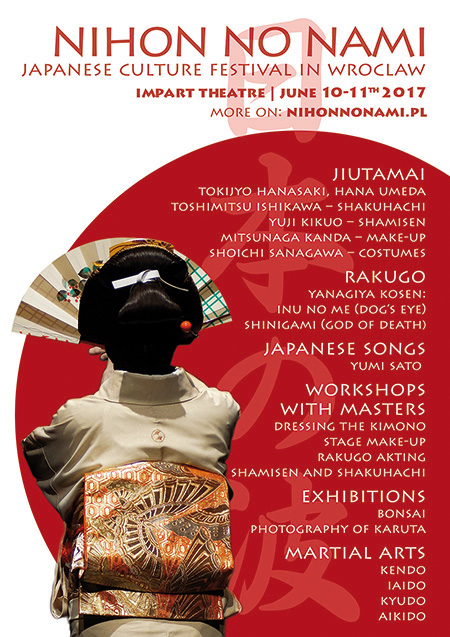
 Nihon no Nami 2017 | leaflet (revers) Nihon no Nami 2017 | leaflet (revers)
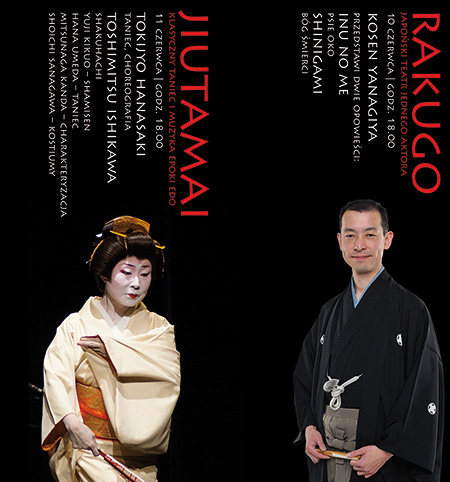
 1st Japanese Culture Festival Nihon no Nami 2017 – photogalleries: 1st Japanese Culture Festival Nihon no Nami 2017 – photogalleries:
 Nihon no Nami opening Nihon no Nami opening

 Jiutamai: Japanese dance and music Jiutamai: Japanese dance and music

 Master Kosen: Rakugo Master Kosen: Rakugo

 Yumi Sato: Japanese songs Yumi Sato: Japanese songs

 Martial arts Martial arts

 Gallery Gallery


 JIUTAMAI: performance of Japanese traditional dance and music | June 11th 6.00 p.m. JIUTAMAI: performance of Japanese traditional dance and music | June 11th 6.00 p.m.
Tokijyo Hanasaki – dance, choreography
Hana Umeda – dance
Toshimitsu Ishikawa – shakuhachi
Yuji Kikuo – shamisen
Mitsunaga Kanda – stage make-up
Shoichi Sanagawa – costumes
Tokijyo Hanasaki is a Japanese dance artist of jiutamai, an unusual art form that came into being in the final phase of the Edo epoch. In jiutamai every movement unveils the human heart. Jiutamai is performed with accompaniment by several traditional Japanese instruments, especially the shamisen.
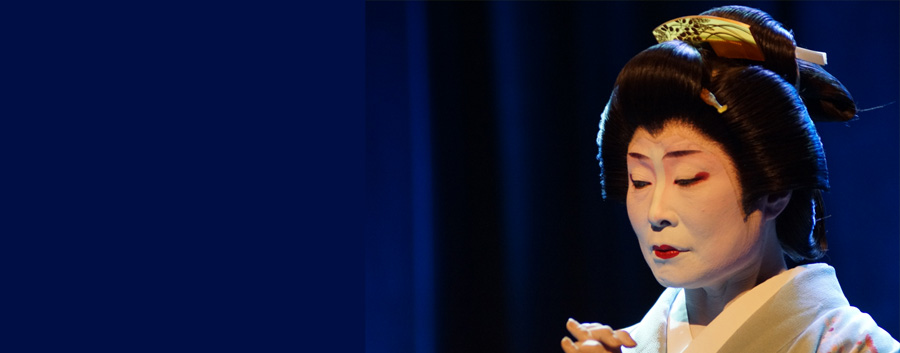
Tokijyo Hanasaki – dancer and choreographer of jiutamai
She created her own unique style of jiutamai Hanasaki-ryu, she also teaches and is engaged in promoting juitamai in the country and abroad. She has performed in Europe on a number of occasions, among others, in France, Lithuania and Poland presenting jiutamai, and, what is more, traditional art forms related to this dance such as the act of donning the kimono – kitsuke, the traditional make-up and the hairdo – Katsura as well as conducting workshops of Japanese dance.
On Youtube:
八島 (Yashima) performed by Tokijyo Hanasaki with accompaniment of Toshimitsu Ishikawa (shakuhachi) and Koichi Kikuse (vocal and shamisen) 
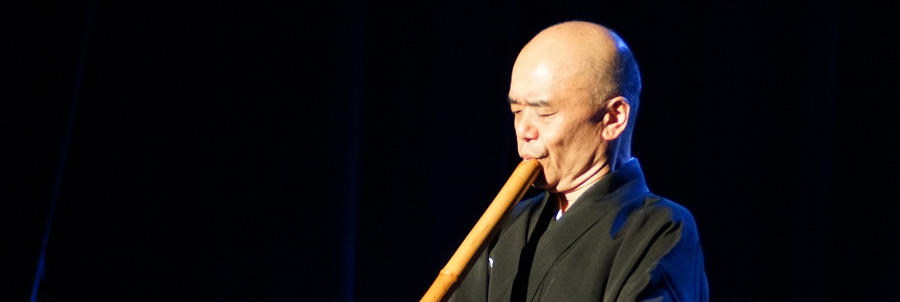
Toshimitsu Ishikawa – shakuhachi master
The winner of music awards (e.g. National Japanese Music Contest), released solo and ensemble CDs, performed in India, USA, Switzerland, Austria, Poland, Belgium, Australia and Singapore. Representative of Osaka Japanese Music Solisten.
On Youtube:
鹿の遠音 (Shika no tone) played by Toshimitsu Ishikawa 

Hana Umeda – performer, dancer and instructor of Nihon Buyo
Since 2006 student of Nishikawa Fukushino from Nishikawa-ryu school in Tokyo. Since 2009 she has been popularizing the classical Japanese dance in Poland. She invented her own method of teaching Nihon Buyo which takes into account the differences in movement of the body between Japanese and Polish people. She created a series of exercises which help Europeans to learn specific Japanese movements. Dance is the area in which her two fatherlands (Poland and Japan) are meeting. As she says, “I have to change my body which was brought up in Polish tradition into the Japanese one, change my natural gestures. For me it is the most intimate physical meeting of Poland and Japan in me”.
The performance, same as the one of the 2016th, is organized in collaboration with Impart Festival Agency and supported by EU-Japan Fest Japan Committee.
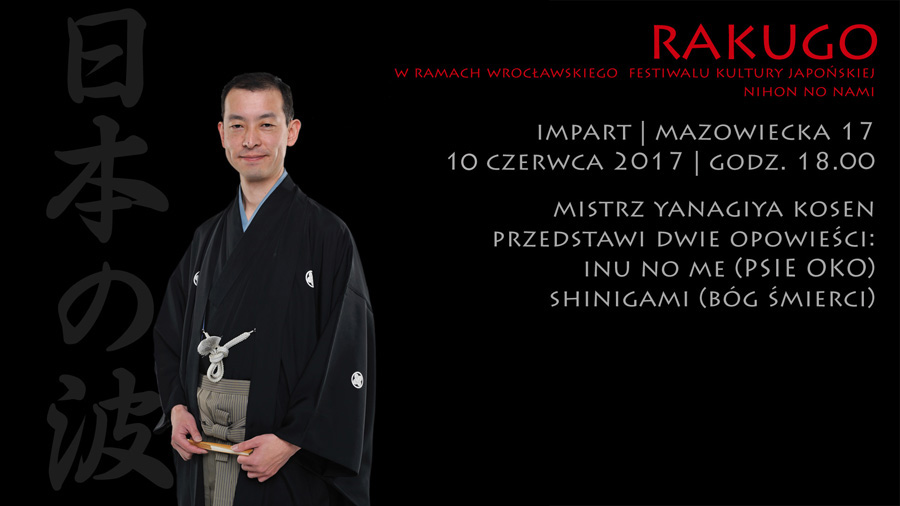
 RAKUGO: Japanese stage comedy of one actor | June 10th 6.00 p.m. RAKUGO: Japanese stage comedy of one actor | June 10th 6.00 p.m.
Master Yanagiya Kosen V will perform two plays: Inu no me (Dog's Eye) and Shinigami (God of Death) – the later popular outside Japane thanks to manga and anime Showa Genroku Rakugo Shinju.
Word-play is integral for rakugo, so stories which can be well translated were chosen, Polish subtitles will be projected over the stage, but English text on leaflets and German abstracts will be available.
What is rakugo?
The Japanese stage art of rakugo is not very well known in Europe.
Europeans are used to stand-up comedy, but rakugo actors/comedians are different. The only thing common is that the comedian is alone on stage, but he kneels on a cushion and does not move for the entire length of the story. All he uses as props are a fan and a hankerchief called tenugui.
But the faces that this Japanese stage art is so different to the European theatre and comedy tradition does not mean Europeans cannot understand and enjoy it. There are hundreds of rakugo stories, some to make you laugh or yet others are moving and make you cry.
Today there are only 700 of rakugo-ka (rakugo actors) in the whole of Japan, mainly in the Osaka and Tokyo areas.
Most Japanese outside these two cities never really have a chance to see rakugo live.
The rakugo-ka only uses two props and he doesn’t change costumes either. In the bat of an eye he turns from a precocious child, to a dumb country boy, a sly prostitute, a rowdy craftsman or a strict wife. Just like the Italian Commedia dell'arte rakugo has its own set of character that appear again the many stories. How these characters are interpreted however depends totally on the actor. Each actor interprets the stories differently, often reacting on the spot-theatre-the actor will chose one of the stories in his repertoire. So even if the audience knows the story, it does not get bored.
In the entrance part, called makura, the actor might talk about something he has seen on TV, his family, about politics or something that just happened backstage. Much of the performance is improvised.
However, since this performance will be sur-titled improvisation is not possible.
It is not easy to become a rakugo-ka. First of all, if a young man finds a master, that he would like to learn with, he approaches him, asking him to become his disciple. In most cases, the master will decline.
If however, after some time, a master does decide to take in a disciple, he not only promises to teach this young man) or in some cases woman) his art, but look after him. Since the master himself has been taught and provided for by his own master during his apprenticeship, he now has to return the favour.
During the first three or so years, the young man works as zenza. During this stage he learns everything at rakugo specialized theaters yose. He serves his elders and mostly does everything backstage to run the stage: folding up kimonos, handing out tea, playing the drum…
On stage, he only does short stories. During these years of apprenticeship he is not allowed to date, drink or smoke.
Once his elders think he knows his art well enough and has mastered the manners necessary for back-stage and on-stage work, he is promoted to futatsume. He no longer has to do the stage work, is allowed to wear a haori-jacket, smoke, drink and date. And he can do longer stories now.
After another 8-12 years of apprenticeship, he becomes shin-uchi, master. In most cases one of the elders decides when the timing is right. In some cases there is also a test to become shin-uchi.
Once a rakugo-ka becomes a master, he can take his own disciples and, what is most important, that he can now be the last to go on stage at the yose-theatre. This privilege is mostly reserved to the eldest and those that are most popular.
by Sarah Stark
To prepare European audience for rakugo, master Ichinosuke Shumputei (the guest of the last years festval) prepared a movie with basic rakugo rules
Watch on Youtube: Master Ichinosuke Shunputei introducing rakugo 
Yanagiya Kosen
June 1974: born in Yokohama, Japan
February 1997: Joins rakugo training with Master Reireisha Baou
April 1997: Receives name "Wakaba"
June 2000: Promotion to futatsume
2002: Winner Kita Topia Wakate Engei Prize
January 2006: Changes to the school of Master Reireisha Bafu
September 2010: Promoted to master. Succession of the name Yanagiya Kosen V
The 2017 Hanagata Engei Prize, Gold Award (First Prize)
The performance, same as the one of the 2016th which was performed by Ichinosuke Shunputei and Koharu Takegawa, is organized in collaboration with Impart Festival Agency and supported by EU-Japan Fest Japan Committee.
The tour is also organized by Zabutontei and Rakugo without borders
rakugowithoutborders@gmail.com
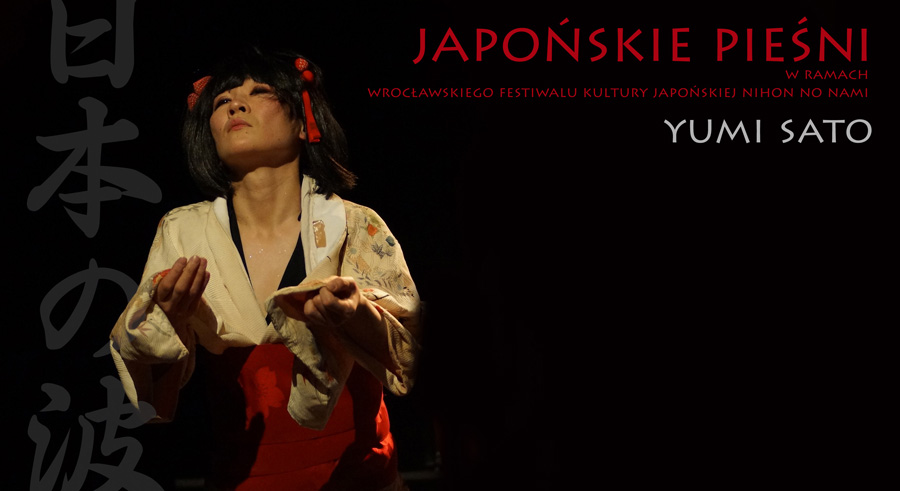
 Japanese traditional songs i and mime etudes performed by YUMI SATO Japanese traditional songs i and mime etudes performed by YUMI SATO
Yumi Sato was born in Shirakawa city, Fukushima Prefecture. She started her theater activities in high school.
In 1999 decided to abondon theater based on dialogue and fully devote herself to mime acting.
In 2013 the International Theatre Festival, which was held in Tokyo, announced her solo work based on the miracle of solitary pine tree and theme of the tree of life.
In 2015 Yumi Sato moved to Poland to become acquainted with the Polish scenic tradition which is very interesting in the city of Wroclaw. She started to exercise with the group continuing traditions of Grotowski’s "Teatr Laboratorium" and finally found her place within the group of "Fundacja Pantomima" (Mime Foundation).
This time (not common for the mime) Yumi Sato will sing Japanese songs and she will sing a cappella.
In the first part of the recital Yumi Sato will sing three popular songs and one poem:
1. Kitakami Yakyoku (北上夜曲) „Kitakami Night” is the song which made a delayed carrier. The lyrics and the melody ware created in 1940/41 by two teenagers: Kikuchi Noriko (1923-1990) and Mutsuo Ando (1924). But not earlier that after the war, the song sang by students from Morioka and Sendai started to come more and more popular. At the beginning of 60'tees the authors were found by recording companies, and the song was finaly recorded by many professional musicians (e.g. Wada Hiroshi and Mahina Stars, Dark Ducks, Miyako Sugawara). In 1974 the song has been honored by the monument in Kitakami.
2. Ye Lai Xiang (夜来香) "Fragrance of the Night" is the famous song by Japanese actress (later also politician) Yoshiko Yamaguchi (1920-2014). She was born in Chinese Manchuria occupied at the time by Japanese army. She was grown under great influence of Chinese culture and became known at the Chinese name Li Xianglan. Despite she was involved by movie companies in the Japanese war propaganda, she became famous both in China and Japan for the "Eternity" (1943). Some songs from the movie (with "Scent of the night as the highlight) entered the canon of Chinese popular music..
3. Kimi Shinitamō koto nakare "Thou Shalt Not Die" (1904) was written by Akiko Yosano (1878-1942), a feminist and pacifist poet.
The poem was addressed to author's younger brother sent as a soldier to fight in the Russian-Japanese war. The poem both recited or sung became a mild anti-war manifesto.
4. Hana ~Subete no Hito no Kokoro ni Hana o~ "Flowers in the Hearts of People" or just „Flowers” is a song by Shoukichi Kina & Champloose, who combined Okinawa's folk with rock and specific sound of electric sanshin. The wife of the group's leader gave her voice to the ballade. The song recoreded in 1980 became popular in Japan, and later widlely recognizable abroad thanks to over 60 covers. In 2006 the ballade was choosen by the Agency for Cultural Affairs as one of 100 songs and melodies reprezenting Japanese culture. The title itself is a reminescence of the Olimpic Games in Tokio 1964 - the speeker expressed his emotion at the closing ceremony by the words subete no hito no kokoro ni hana.
More information on the second part of the concert soon.
 Workshops of the Japanese masters Workshops of the Japanese masters
[More information soon]

Rakugo – workshop introducing basic principles of rakugo acting (Yanagiya Kosen)

Kitsuke – workshop of the art to dress a kimono (Tokijyo Hansaki, Hana Umeda)

Kaoshi – show-workshop of the Japanese stage make-up (Mitsunaga Kanda)

Shakuhachi – workshop of the Japanese bamboo flute for amateurs and proffessional musicians (Toshimitsu Ishikawa)
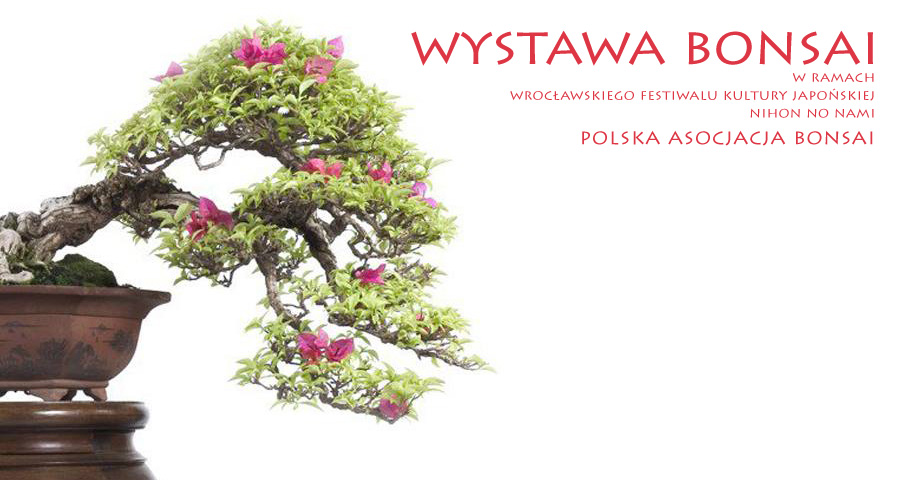
 Bonsai exhibition – by Polish Bonsai Association Bonsai exhibition – by Polish Bonsai Association
[More information soon]
 Japanese martial arts Japanese martial arts
[More information and full translation soon]

– Kendō (剣道) dosłownie „droga miecza”, to japońska szermierka wywodząca się z ćwiczebnych technik samurajskich. Walczy się bambusowym mieczem (shinai), a bezpieczeństwo zapewnia zbroja (bōgu). Punktowane są cięcia w głowę (men), brzuch (dō) i nadgarstek (kote) oraz pchnięcie (tsuki) w gardło.

– Iaidō (居合道) oznacza „bycie w ciągłej gotowości”, a w domyśle chodzi tu o gotowość do błyskawicznego stawienia czoła przeciwnikowi, dobycie miecza i cięcie. Ćwiczy się metalowym, zwykle niezaostrzonym mieczem zwanym iaitō, tylko mistrzowie tej sztuki używają zaostrzonej katany.

– Kyūdō (弓道) dosłownie „droga łuku”, to praktykowane współcześnie japońskie tradycyjne łucznictwo. Charakterystyczny niesymetryczny łuk (dłuższy w górnej części, krótszy w dolnej) został opisany pierwszy raz we fragmencie chińskiej kroniki Weishu z końca III wieku dotyczącym Wysp Japońskich. Od XVII wieku łucznictwo zaczęło przekształcać się z techniki wojskowej w formę bardziej ceremonialną, a pod wpływem buddyzmu Zen także w drogę wewnętrznego doskonalenia.

– Aikidō (合気道) tłumaczy się zwykle jako „zjednoczenie z energią życiową”, zostało stworzone niespełna 100 lat temu przez Morihei Ueshibę na bazie wcześniejszych technik jako sposób obrony bez zadawania ran przeciwnikowi. Polega głównie na wykorzystaniu i przekierowaniu siły i ruchu atakującego przeciwnika prowadzącym do obezwładniającego go chwytu lub rzutu. W aikido nie rozgrywa się zawodów, tylko doskonali umiejętności poprzez ćwiczenie.
 Lectures, workshops, games Lectures, workshops, games
[More information soon]
 Japanese kindergarten Japanese kindergarten
[More information soon]

Origami

Dobutsu shogi

How to use chopsticks

Dressing with youkata and hakama
 PROGRAM OF THE FESTIVAL PROGRAM OF THE FESTIVAL
*Stars remark events with additional reservation or tickets
Saturday | June 10th
15.00-16.00 | Opening event, presentation of the gueste and short music and dance show
16.00-18.00 | Demonstration of Japanese martial arts by clubs and associations of kendo, iaido, aikido and kyudo | samurai fighting in historic armour (Kabuto group) | comedy sketches of samurai life (Yumi Sato)
*16.00-17.00 | Kitsuke workshop – the art to dress with kimono (Tokijyo Hansaki, Hana Umeda)
*17.00-18.00 | Stage make-up =workshop scenicznego (Mitsunaga Kanda)
*16.00-18.00 | Shakuhachi workshop – japońskiego fletu bambusowago (Toshimitsu Ishikawa)
*18.00-20.00 | RAKUGO: Kosen Yanagiya presnts: Inu no me (Dog's eye) and Shinigami (God og death) | QA session just after the show
Sunday | June 11th
15:00-16:00 | Japanese traditional songs by Yumi Sato
16.00-17.00 | The art of bonsai – demonstration and lecture (Polish Bonsai Association)
17.00-18.00 | Karuta – card game of poems on photography (Bartosz Holoszkiewicz)
*15.00-18.00 | Rakugo workshop – basics of the art acting (Kosen Yanagiya)
*18.00-20.00 | JIUTAMAI: Japanese music and dance
Hall and galeries (all the time):
BONSAI EXHIBITION by Polish Bonsai Association
Japanese kindergarten: origami, Japanese dress, chopsticks, "Let's catch the Lion" (Dobutsu shogi) strategy game for children
Japanese games: go, shogi (Japanese chess)
Japanese customs and traditions: caligraphy (shodo), kanzashi
Japanese cusine
 Tickets | Booking Tickets | Booking
We offer reducet tickets for children and students up to 26th
- Two-days entrance fee not including Ragugo and Jiutamai shows nor the Japanese Masters Workshops – 20/10 zł (5/2,5 Euro)
- Two-days entrance fee including Rakugo show – 30/20 zł (7,50/5 Euro)
- Two-days entrance fee including Jiutamai show – 50/30 zł (12,50/7,50 Euro)
- Two-days "all inclusive" ticket, including Jiutamai and Rakugo shows and enables booking for two of the Japanese Masters Workshops – 100/70 zł (25/17,50 Euro)
Booking and Information:
Julian Gorski
julian.gorski@fundacja-nami.pl, mob. +48 663 571 823
Bank account:
Fundacja Przyjaźni Polsko-Japońskiej NAMI
ul. Legnicka 65, 54-206 Wrocław
(Transfers in Euro): IBAN PL 06 2030 0045 3110 0000 0027 1410
SWIFT CORD: GOPZPLPW
(in Zloty): BANK BGŻ 60 2030 0045 1110 0000 0315 2980
in the title of remittance please write:
[your name] [numeber of the tickets] [ticket type]
 Contact us | About us Contact us | About us

Fundacja Przyjaźni Polsko-Japońskiej NAMI (Polish-Japanese Friendship Foundation NAMI)
ul. Legnicka 65, 54-206 Wrocław
Biuro Festiwalowe Impart 2016 (Festival Agency Impart 2016)
ul. Komuny Paryskiej 39-41, 50-451 Wrocław
Contact us:
In the matter of organization:
– Grażyna Pogorzelska: grazyna.pogorzelska@fundacja-nami.pl, mob. (+48) 784 694 592
– Julian Górski: julian.gorski@fundacja-nami.pl, mob. (+48) 663 571 823
Programme:
– Maciej Pogorzelski: maciej.pogorzelski@fundacja-nami.pl, mob. (+48) 502 796 050
Volunteers:
– Zdzisław Koczarski: zdzislaw.koczarski@gmail.com
Impart Festival Agency
– Katarzyna Młyńczak-Sachs
Cooperation:
– Zabutontei
– Rakugo without borders
– Ryushinkai (kendo)
– Renshinkan (iaido)
– Polskie Stowarzyszenie Kyudo
– Aikikai Wrocław
– Birankai Polska
|
|
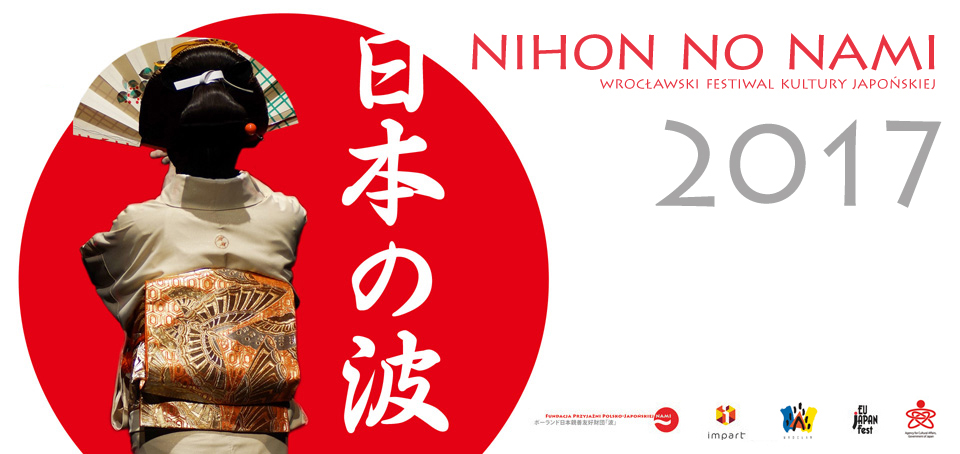


 RAKUGO: Japanese stage comedy of one actor | June 10th 6.00 p.m.
RAKUGO: Japanese stage comedy of one actor | June 10th 6.00 p.m.
 Japanese traditional songs i and mime etudes performed by YUMI SATO
Japanese traditional songs i and mime etudes performed by YUMI SATO Workshops of the Japanese masters
Workshops of the Japanese masters
 Bonsai exhibition – by Polish Bonsai Association
Bonsai exhibition – by Polish Bonsai Association Japanese martial arts
Japanese martial arts Lectures, workshops, games
Lectures, workshops, games Japanese kindergarten
Japanese kindergarten PROGRAM OF THE FESTIVAL
PROGRAM OF THE FESTIVAL Contact us | About us
Contact us | About us